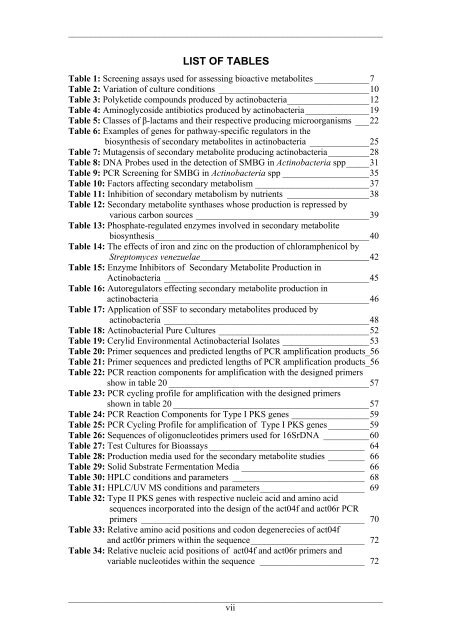Detection and Expression of Biosynthetic Genes in Actinobacteria ...
Detection and Expression of Biosynthetic Genes in Actinobacteria ...
Detection and Expression of Biosynthetic Genes in Actinobacteria ...
Create successful ePaper yourself
Turn your PDF publications into a flip-book with our unique Google optimized e-Paper software.
_____________________________________________________________________LIST OF TABLESTable 1: Screen<strong>in</strong>g assays used for assess<strong>in</strong>g bioactive metabolites ____________7Table 2: Variation <strong>of</strong> culture conditions _________________________________10Table 3: Polyketide compounds produced by act<strong>in</strong>obacteria__________________12Table 4: Am<strong>in</strong>oglycoside antibiotics produced by act<strong>in</strong>obacteria______________19Table 5: Classes <strong>of</strong> β-lactams <strong>and</strong> their respective produc<strong>in</strong>g microorganisms ___22Table 6: Examples <strong>of</strong> genes for pathway-specific regulators <strong>in</strong> thebiosynthesis <strong>of</strong> secondary metabolites <strong>in</strong> act<strong>in</strong>obacteria _____________25Table 7: Mutagensis <strong>of</strong> secondary metabolite produc<strong>in</strong>g act<strong>in</strong>obacteria_________28Table 8: DNA Probes used <strong>in</strong> the detection <strong>of</strong> SMBG <strong>in</strong> Act<strong>in</strong>obacteria spp_____31Table 9: PCR Screen<strong>in</strong>g for SMBG <strong>in</strong> Act<strong>in</strong>obacteria spp ___________________35Table 10: Factors affect<strong>in</strong>g secondary metabolism _________________________37Table 11: Inhibition <strong>of</strong> secondary metabolism by nutrients __________________38Table 12: Secondary metabolite synthases whose production is repressed byvarious carbon sources ______________________________________39Table 13: Phosphate-regulated enzymes <strong>in</strong>volved <strong>in</strong> secondary metabolitebiosynthesis_______________________________________________40Table 14: The effects <strong>of</strong> iron <strong>and</strong> z<strong>in</strong>c on the production <strong>of</strong> chloramphenicol byStreptomyces venezuelae_____________________________________42Table 15: Enzyme Inhibitors <strong>of</strong> Secondary Metabolite Production <strong>in</strong>Act<strong>in</strong>obacteria _____________________________________________45Table 16: Autoregulators effect<strong>in</strong>g secondary metabolite production <strong>in</strong>act<strong>in</strong>obacteria ______________________________________________46Table 17: Application <strong>of</strong> SSF to secondary metabolites produced byact<strong>in</strong>obacteria _____________________________________________48Table 18: Act<strong>in</strong>obacterial Pure Cultures _________________________________52Table 19: Cerylid Environmental Act<strong>in</strong>obacterial Isolates ___________________53Table 20: Primer sequences <strong>and</strong> predicted lengths <strong>of</strong> PCR amplification products_56Table 21: Primer sequences <strong>and</strong> predicted lengths <strong>of</strong> PCR amplification products_56Table 22: PCR reaction components for amplification with the designed primersshow <strong>in</strong> table 20 ____________________________________________57Table 23: PCR cycl<strong>in</strong>g pr<strong>of</strong>ile for amplification with the designed primersshown <strong>in</strong> table 20 ___________________________________________57Table 24: PCR Reaction Components for Type I PKS genes _________________59Table 25: PCR Cycl<strong>in</strong>g Pr<strong>of</strong>ile for amplification <strong>of</strong> Type I PKS genes_________59Table 26: Sequences <strong>of</strong> oligonucleotides primers used for 16SrDNA __________60Table 27: Test Cultures for Bioassays __________________________________ 64Table 28: Production media used for the secondary metabolite studies ________ 66Table 29: Solid Substrate Fermentation Media ___________________________ 66Table 30: HPLC conditions <strong>and</strong> parameters _____________________________ 68Table 31: HPLC/UV MS conditions <strong>and</strong> parameters_______________________ 69Table 32: Type II PKS genes with respective nucleic acid <strong>and</strong> am<strong>in</strong>o acidsequences <strong>in</strong>corporated <strong>in</strong>to the design <strong>of</strong> the act04f <strong>and</strong> act06r PCRprimers _________________________________________________ 70Table 33: Relative am<strong>in</strong>o acid positions <strong>and</strong> codon degenerecies <strong>of</strong> act04f<strong>and</strong> act06r primers with<strong>in</strong> the sequence_________________________ 72Table 34: Relative nucleic acid positions <strong>of</strong> act04f <strong>and</strong> act06r primers <strong>and</strong>variable nucleotides with<strong>in</strong> the sequence _______________________ 72_____________________________________________________________________vii















